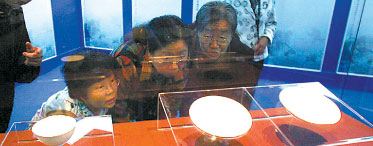Raising China's Titanic
The Nanhai No 1, a Song Dynasty (AD 960-1279) merchant vessel, was raised from the ocean seabed off the coast of Guangdong province where it had lain for 800 years in December 2007. Dubbed the Titanic of China, it was a national media sensation.
Items of its trove are now on display at the Duanmen Rostrum, the temporary exhibition hall of the China National Museum.
The bright colors and shining glaze of these ceramics make it difficult to believe that they have spent eight centuries in a sunken ship on the ocean bed. The 36 precious cultural relics on display are like a legend unlocked from the wreck of the Nanhai No 1 (South China Sea No 1) after 20 years of underwater archeological research.

The objects, which include pots, jars, bowls and plates, display various glaze techniques. Arranged within glass cabinets, the seven-petal plain porcelain plate, white glazed caster-vein bowl and green and gray-blue glazed jars and pots seem to emit a soft glow.
As cargo for export, the ceramics are both practical and exotic in order to satisfy the aesthetic requirements of their target destination.
"The show also aims to introduce the underwater archeological research of the China National Museum since 1987 when the Nanhai No 1 was discovered," said Huang Chen, director of the publicity department of the museum and curator of the latest show. "The exhibits and cultural relics that have been salvaged from the ship provide material for the study of marine transportation, trade and ancient shipbuilding industry."
Among the 60,000 ceramics and other antiques found in the wreck, about 4,500 pieces are either intact or capable of restoration.
Ceramics constitute the majority of the cargo, which also contains gold and silverware, lacquer ware, coins and jewels. After examining the 10,000 or so coins in the cargo, experts have determined that it is a Song Dynasty vessel.
The 36 exhibits on show, originating in the Southern Song Dynasty (AD 1127-1279), are representative of the overall style of the trove discovered in 1987 and raised in 2007. It is regarded as an historical retrieval. Twenty years of research and exploration of the sunken ship have brought considerable progress to China's under-water archeological work.
The ship was named the Nanhai No 1 by archaeologists because it is the first ancient vessel to have been discovered in that area, and the largest Song Dynasty ship ever salvaged.
The 30-m-long ship was buried in thick seabed silt that protected its precious trove from the destructive impingement of seawater. The wreck is now preserved in a specially built glass container in the Marine Silk Road Museum of Guangdong.
Research into the of Nanhai No 1 has significantly promoted underwater archaeological exploration in China, according to Zhang Wei, founder of China's underwater archeology team and director of the Underwater Archaeology Research Center of China (UARCC).
Founded in 1987, the UARCC has been involved in investigation, prospecting, excavation and research of all kinds of underwater cultural relics, ruins and vessels.
A branch subject of archeology, underwater archeology in China has progressed during the past two decades and is regarded an Asian leader in the field, according to Zhang.
Photographs and texts giving details of the retrieved cargo accompany the actual exhibits.
An exhibition of high quality replicas of Ming and Qing dynasty ceramic masterpieces will be held in the Duanmen Rostrum hall over the same period.
Entitled Appeal of National Treasures, it explores the splendid craftsmanship and spiritual world of ancient masters.
Among the exhibits are replicas of a Qing Dynasty (1644-1911) color-glazed porcelain bottle with open carvings in a dragon design and a Ming dynasty (1368-1644) blue-and-white porcelain flat pot decorated with an ocean wave design.
Story by Wu Liping, photo by Jiang Dong
8:30 am-5 pm, until Aug 31
Duan Gate of the Forbidden City, north of Tian'anmen Rostrum, Dongcheng District
8447-4943
紫禁城端门
(China Daily 06/07/2008 page6)














